S2S Haiti - Zonal statistics#
Zonal statistics are run on the standardized H3 grid; the process is run on a country-by-country basis.
For the zonal statistics, each zonal statistic is run against the source dataset as a whole, then it is stratified by urban classification from the European Commission - GHS-SMOD. This creates an summary dataset that has the standard zonal stats columns (SUM, MEAN, MAX, MIN) as well as the same for urban areas (SUM_urban, MEAN_urban, MAX_urban, MIN_urban).
Show code cell source
import sys, os, importlib, math, multiprocessing
import rasterio, geojson
import pandas as pd
import geopandas as gpd
import numpy as np
from h3 import h3
from tqdm import tqdm
from shapely.geometry import Polygon
sys.path.insert(0, "/home/wb411133/Code/gostrocks/src")
import GOSTRocks.rasterMisc as rMisc
import GOSTRocks.ntlMisc as ntl
import GOSTRocks.mapMisc as mapMisc
from GOSTRocks.misc import tPrint
sys.path.append("../src")
import h3_helper
import country_zonal
%load_ext autoreload
%autoreload 2
Show code cell source
sel_iso3 = "HTI"
h3_level = 6
admin_bounds = "/home/public/Data/GLOBAL/ADMIN/ADMIN2/HighRes_20230328/shp/WB_GAD_ADM2.shp"
out_folder = f"/home/wb411133/projects/Space2Stats/{sel_iso3}"
if not os.path.exists(out_folder):
os.makedirs(out_folder)
global_urban = "/home/public/Data/GLOBAL/GHSL/SMOD/GHS_SMOD_E2020_GLOBE_R2023A_54009_1000_V1_0.tif"
inA = gpd.read_file(admin_bounds)
selA = inA.loc[inA['ISO_A3'] == sel_iso3].copy()
selA['ID'] = selA.index #Create ID for indexing
inU = rasterio.open(global_urban)
# As a demo, we will process with nighttime lights layers
ntl_layers = ntl.aws_search_ntl()
ntl_file = ntl_layers[-1]
Generate zonal statistics at h3 based on urbanization levels#
Show code cell source
def get_per(x):
try:
return(x['SUM_urban']/x['SUM'] * 100)
except:
return(0)
Population#
Show code cell source
global_pop_layer = "/home/public/Data/GLOBAL/GHSL/Pop/GHS_POP_E2020_GLOBE_R2023A_54009_100_V1_0.tif"
zonalC = country_zonal.country_h3_zonal(sel_iso3, selA, "ID", h3_level, out_folder)
zonal_res_pop = zonalC.zonal_raster_urban(global_pop_layer, global_urban)
100%|██████████| 202/202 [00:01<00:00, 196.99it/s]
map_data_pop = zonal_res_pop.sort_values("SUM_urban").loc[:,['shape_id','SUM','SUM_urban']].copy()
map_data_pop = pd.merge(zonalC.h3_cells, map_data_pop, on='shape_id')
map_data_pop['per_urban'] = map_data_pop.apply(get_per, axis=1)
map_data_pop.sort_values('SUM')
| index | geometry | shape_id | index_right | ID | SUM | SUM_urban | per_urban | |
|---|---|---|---|---|---|---|---|---|
| 21 | 864c8a817ffffff | POLYGON ((-72.75291 20.09093, -72.77929 20.077... | 864c8a817ffffff | 36452 | 36452 | -238.286994 | 0.0 | -0.000000 |
| 73 | 864c8ad4fffffff | POLYGON ((-72.92188 20.09102, -72.94830 20.077... | 864c8ad4fffffff | 36452 | 36452 | -229.921339 | 60.0 | -26.095881 |
| 13 | 864c8a8a7ffffff | POLYGON ((-72.80921 20.09098, -72.83560 20.077... | 864c8a8a7ffffff | 36452 | 36452 | -128.124768 | 413.0 | -322.342048 |
| 602 | 8667258a7ffffff | POLYGON ((-72.03023 18.64439, -72.05657 18.630... | 8667258a7ffffff | 36503 | 36503 | 0.000000 | 0.0 | 0.000000 |
| 693 | 8667258afffffff | POLYGON ((-71.99667 18.60254, -72.02300 18.588... | 8667258afffffff | 36493 | 36493 | 0.000000 | 0.0 | 0.000000 |
| ... | ... | ... | ... | ... | ... | ... | ... | ... |
| 679 | 866725c1fffffff | POLYGON ((-72.33478 18.60207, -72.36120 18.588... | 866725c1fffffff | 36488 | 36488 | 223787.948762 | 222807.0 | 99.561661 |
| 486 | 864c88687ffffff | POLYGON ((-72.20424 19.76281, -72.23052 19.749... | 864c88687ffffff | 36418 | 36418 | 233049.883958 | 231887.0 | 99.501015 |
| 528 | 866725c8fffffff | POLYGON ((-72.41407 18.55991, -72.44051 18.545... | 866725c8fffffff | 36487 | 36487 | 236411.146463 | 234849.0 | 99.339225 |
| 105 | 866725ce7ffffff | POLYGON ((-72.30118 18.56020, -72.32759 18.546... | 866725ce7ffffff | 36501 | 36501 | 320978.277533 | 319626.0 | 99.578701 |
| 186 | 866725cf7ffffff | POLYGON ((-72.35761 18.56006, -72.38404 18.546... | 866725cf7ffffff | 36501 | 36501 | 431109.360584 | 430148.0 | 99.777003 |
989 rows × 8 columns
map_plt = mapMisc.static_map_vector(map_data_pop, "SUM", thresh=[50, 1000, 5000, 10000, 50000, 100000, 500000, 1500000], figsize=(15, 15))
map_plt.title("Total population")
map_plt.show()
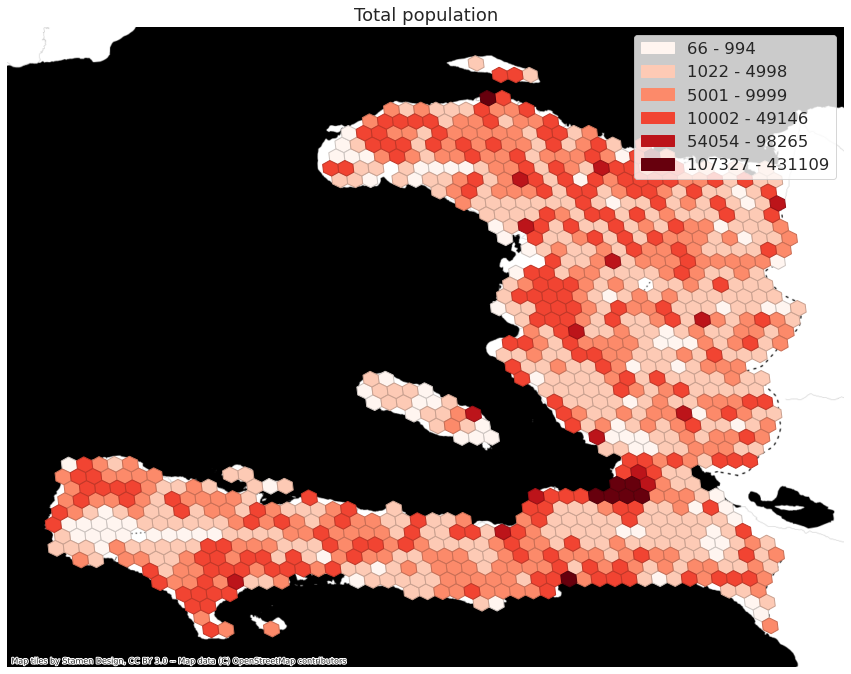
map_plt = mapMisc.static_map_vector(map_data_pop, "per_urban", thresh=[0, 20, 40, 60, 80, 100, 1000], figsize=(15,15))
map_plt.title("Percent population in urban areas")
map_plt.show()
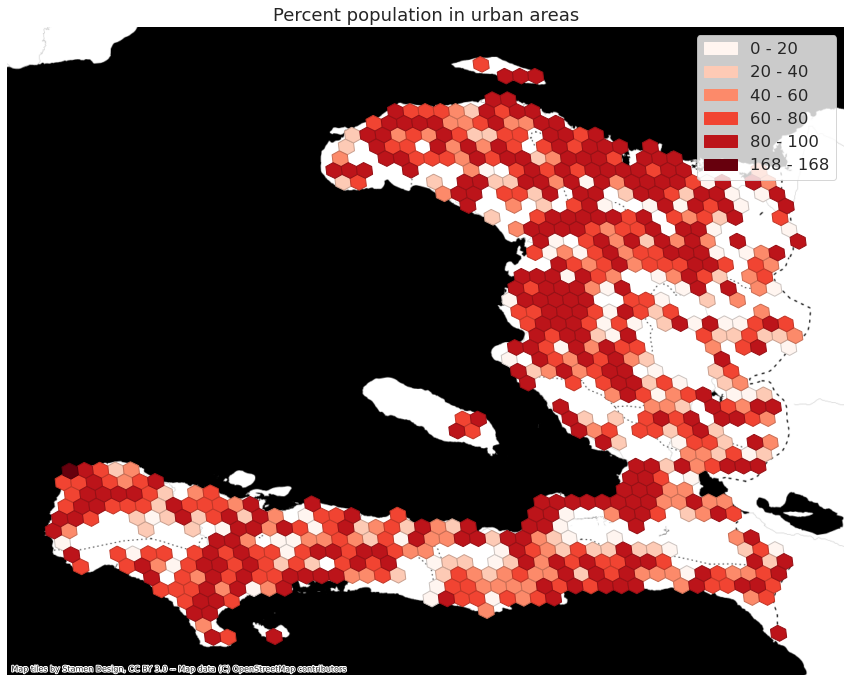
Nighttime Lights#
zonalC = country_zonal.country_h3_zonal(sel_iso3, selA, "ID", h3_level, out_folder)
zonal_res = zonalC.zonal_raster_urban(ntl_file, global_urban)
100%|██████████| 202/202 [00:01<00:00, 198.70it/s]
map_data = zonal_res.sort_values("SUM_urban").loc[:,['shape_id','SUM','SUM_urban']].copy()
map_data = pd.merge(zonalC.h3_cells, map_data, on='shape_id')
map_data['per_urban'] = map_data.apply(get_per, axis=1)
map_data.sort_values('SUM')
| index | geometry | shape_id | index_right | ID | SUM | SUM_urban | per_urban | |
|---|---|---|---|---|---|---|---|---|
| 339 | 866725157ffffff | POLYGON ((-71.99766 18.39270, -72.02401 18.378... | 866725157ffffff | 36490 | 36490 | 38.020000 | 0.0 | 0.000000 |
| 718 | 86672515fffffff | POLYGON ((-71.96406 18.35068, -71.99041 18.336... | 86672515fffffff | 36492 | 36492 | 38.529999 | 0.0 | 0.000000 |
| 98 | 86672514fffffff | POLYGON ((-71.90776 18.35075, -71.93409 18.336... | 86672514fffffff | 36492 | 36492 | 38.549999 | 0.0 | 0.000000 |
| 345 | 866725027ffffff | POLYGON ((-72.05399 18.39262, -72.08036 18.378... | 866725027ffffff | 36490 | 36490 | 38.550003 | 0.0 | 0.000000 |
| 168 | 8667250a7ffffff | POLYGON ((-72.18953 18.35026, -72.21594 18.336... | 8667250a7ffffff | 36476 | 36476 | 38.949997 | 0.0 | 0.000000 |
| ... | ... | ... | ... | ... | ... | ... | ... | ... |
| 946 | 864c8b977ffffff | POLYGON ((-71.73426 19.59698, -71.76043 19.583... | 864c8b977ffffff | 36440 | 36440 | 359.739990 | 256.0 | 71.162508 |
| 186 | 866725cf7ffffff | POLYGON ((-72.35761 18.56006, -72.38404 18.546... | 866725cf7ffffff | 36501 | 36501 | 635.240051 | 554.0 | 87.211126 |
| 386 | 866725c0fffffff | POLYGON ((-72.27837 18.60219, -72.30477 18.588... | 866725c0fffffff | 36502 | 36502 | 740.360046 | 673.0 | 90.901718 |
| 105 | 866725ce7ffffff | POLYGON ((-72.30118 18.56020, -72.32759 18.546... | 866725ce7ffffff | 36501 | 36501 | 817.319946 | 750.0 | 91.763330 |
| 679 | 866725c1fffffff | POLYGON ((-72.33478 18.60207, -72.36120 18.588... | 866725c1fffffff | 36488 | 36488 | 1188.530029 | 1113.0 | 93.645089 |
989 rows × 8 columns
map_plt = mapMisc.static_map_vector(map_data, "SUM", thresh=[5,10,50,100,500,1000,7000], figsize=(15,15))
map_plt.title("Total nighttime lights brightness")
map_plt.show()
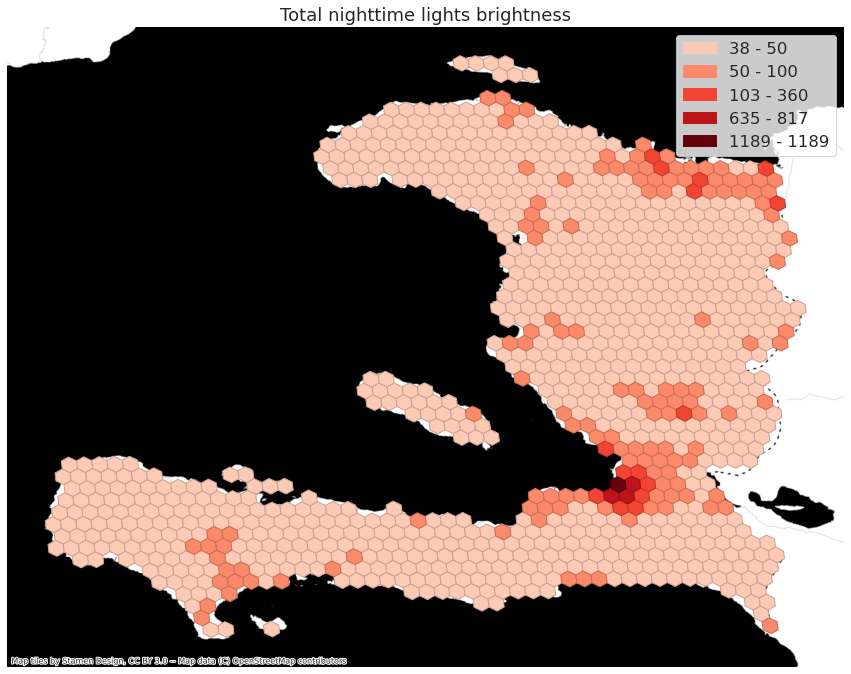
map_plt = mapMisc.static_map_vector(map_data, "per_urban", figsize=(15,15))
map_plt.title("Percent nighttime lights from urban areas")
map_plt.show()
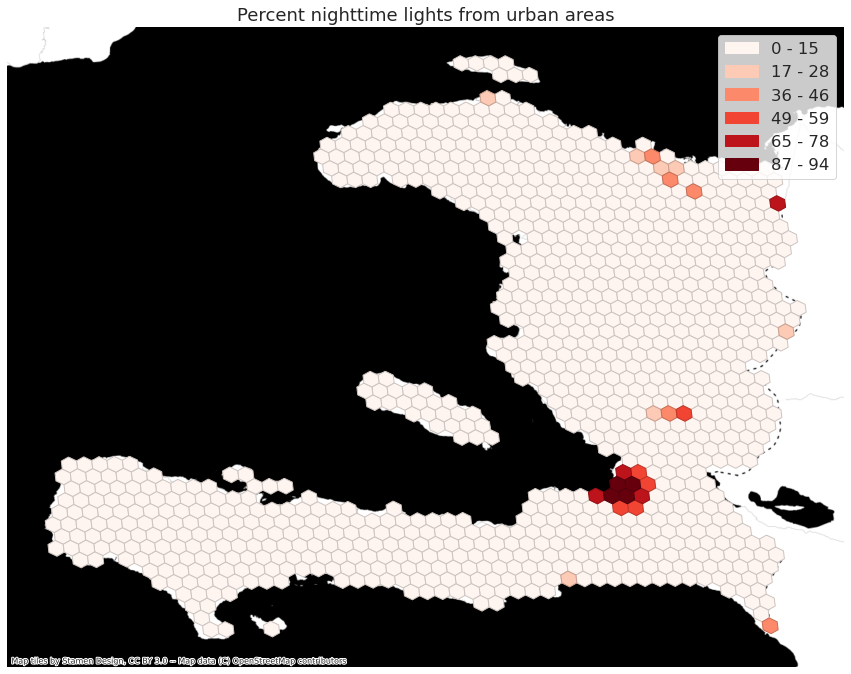
Join h3 zonal results to admin boundaries#
below we compare timing the administrative summaries with and without fractional intersections. While there is a difference between the two, the overall process is quite fast. As the is no computational limitation, we will rely on the fractional intersection as it is more accurate.
### These two cells are used to test the speed of joining with and without fractional intersection
%timeit cur_res = country_zonal.connect_polygons_h3_stats(selA, zonal_res, h3_level, "ID", True)
7.18 s ± 78 ms per loop (mean ± std. dev. of 7 runs, 1 loop each)
%timeit cur_res = country_zonal.connect_polygons_h3_stats(selA, zonal_res, h3_level, "ID", False)
6.76 s ± 17.2 ms per loop (mean ± std. dev. of 7 runs, 1 loop each)
cur_res = country_zonal.connect_polygons_h3_stats(selA, zonal_res_pop, h3_level, "ID", True)
map_admin = pd.merge(selA, cur_res, left_on="ID", right_on='id')
map_admin['per_urban'] = map_admin.apply(get_per, axis=1)
map_plt = mapMisc.static_map_vector(map_admin, "SUM", figsize=(15,15))
map_plt.title("Total Population")
map_plt.show()
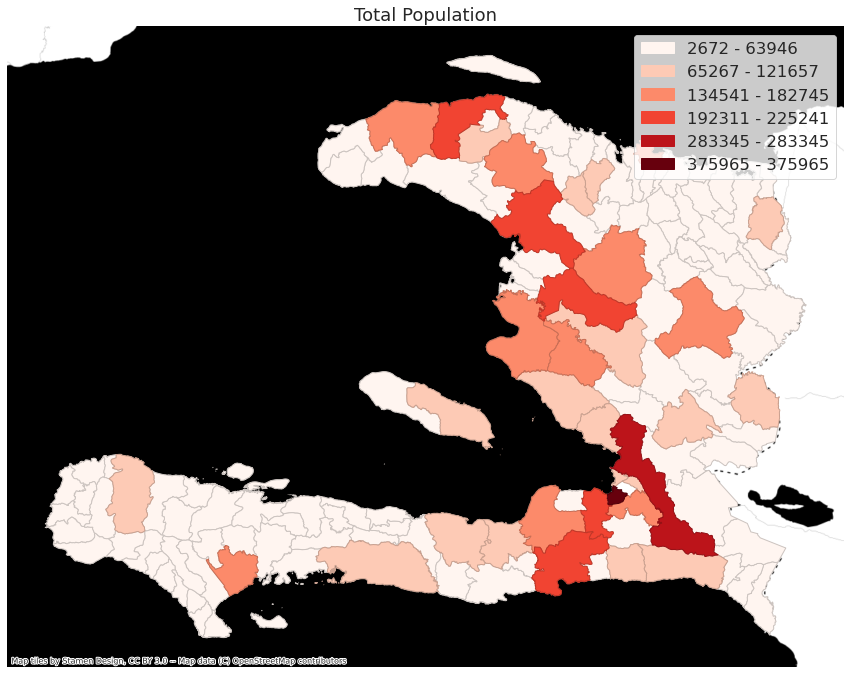
map_plt = mapMisc.static_map_vector(map_admin, "per_urban", figsize=(15,15))
map_plt.title("Percent uban population")
map_plt.show()
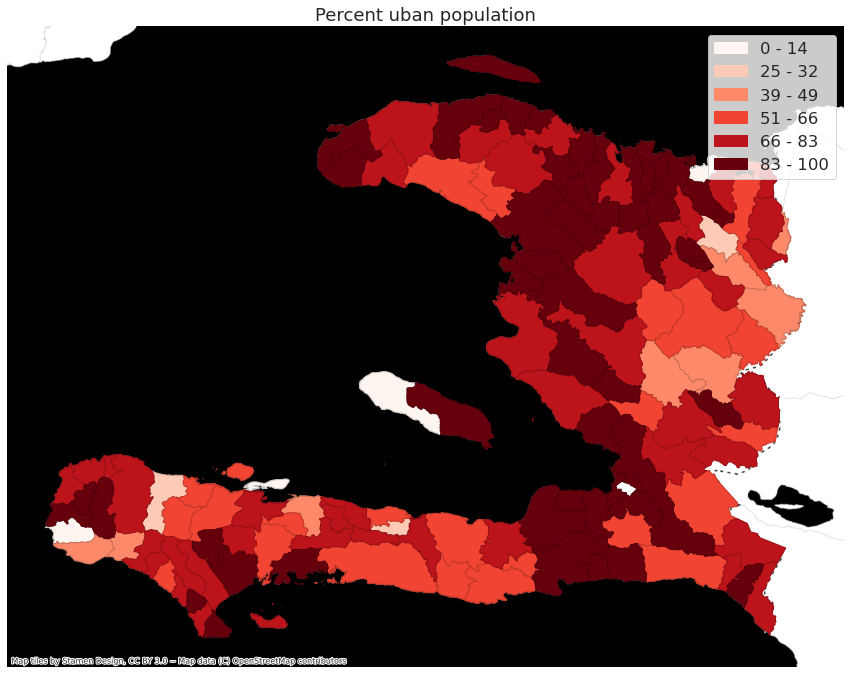
Write output#
map_data_pop.to_file(os.path.join(out_folder, "h3_urban_pop.geojson"), driver="GeoJSON")
